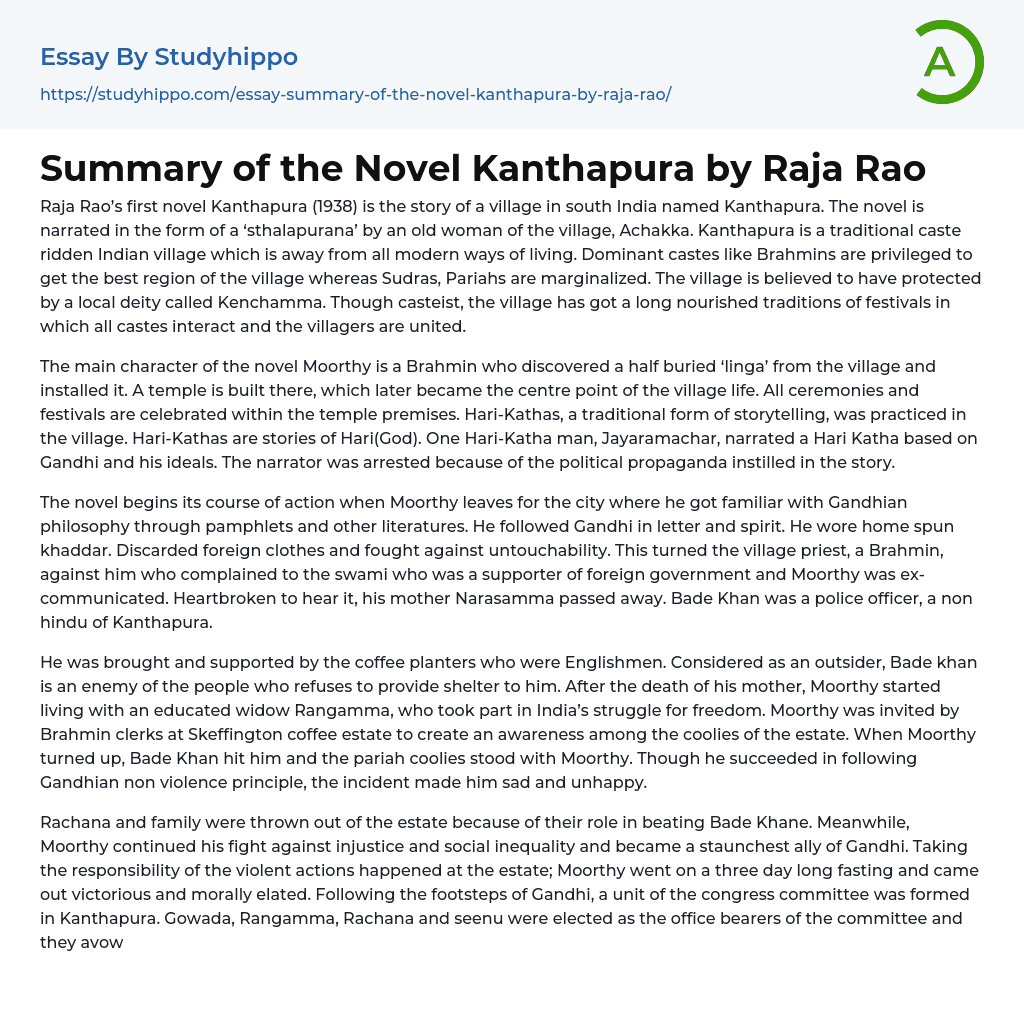Raja Rao’s first novel Kanthapura (1938) is the story of a village in south India named Kanthapura. The novel is narrated in the form of a ‘sthalapurana’ by an old woman of the village, Achakka. Kanthapura is a traditional caste ridden Indian village which is away from all modern ways of living. Dominant castes like Brahmins are privileged to get the best region of the village whereas Sudras, Pariahs are marginalized. The village is believed to have protected by a local deity called Kenchamma. Though casteist, the village has got a long nourished traditions of festivals in which all castes interact and the villagers are united.
The main character of the novel Moorthy is a Brahmin who discovered a half buried ‘linga’ from the village and installed it. A temple is built there, which later became the centre point
...of the village life. All ceremonies and festivals are celebrated within the temple premises. Hari-Kathas, a traditional form of storytelling, was practiced in the village. Hari-Kathas are stories of Hari(God). One Hari-Katha man, Jayaramachar, narrated a Hari Katha based on Gandhi and his ideals. The narrator was arrested because of the political propaganda instilled in the story.
The novel begins its course of action when Moorthy leaves for the city where he got familiar with Gandhian philosophy through pamphlets and other literatures. He followed Gandhi in letter and spirit. He wore home spun khaddar. Discarded foreign clothes and fought against untouchability. This turned the village priest, a Brahmin, against him who complained to the swami who was a supporter of foreign government and Moorthy was ex-communicated. Heartbroken to hear it, his mother
Narasamma passed away. Bade Khan was a police officer, a non hindu of Kanthapura.
He was brought and supported by the coffee planters who were Englishmen. Considered as an outsider, Bade khan is an enemy of the people who refuses to provide shelter to him. After the death of his mother, Moorthy started living with an educated widow Rangamma, who took part in India’s struggle for freedom. Moorthy was invited by Brahmin clerks at Skeffington coffee estate to create an awareness among the coolies of the estate. When Moorthy turned up, Bade Khan hit him and the pariah coolies stood with Moorthy. Though he succeeded in following Gandhian non violence principle, the incident made him sad and unhappy.
Rachana and family were thrown out of the estate because of their role in beating Bade Khane. Meanwhile, Moorthy continued his fight against injustice and social inequality and became a staunchest ally of Gandhi. Taking the responsibility of the violent actions happened at the estate; Moorthy went on a three day long fasting and came out victorious and morally elated. Following the footsteps of Gandhi, a unit of the congress committee was formed in Kanthapura. Gowada, Rangamma, Rachana and seenu were elected as the office bearers of the committee and they avowed to follow Gandhi’s teachings.
Fearing the greater mobility of people of Kanthapura under the leadership of Moorthy, the foreign government accused him of provoking people to inflict violence it and arrested him. Though Rangamma and Rachana were willing to release him on bail, he refused. He was punished for three years rigorous imprisonment. While Moorthy spent his days in prison, the women
of Kanthapura took charge of the struggle for freedom. They formed Women’s Volunteer Corps under the leadership of Rangamma who instilled patriotism among the women by presenting thr historical figures like Laxmi Bai of thansi, rajput princess, Sarojini Naidu etc...
Moorthy was released later and he came out as strong as he was. People thronged at his house were dispersed peacefully. Dandi March, Picketting of Boranna’s toddy grove were other activities led by Moorthy after his release. Arrest of the satyagrhis, and police brutality to women became a part of the everyday life of the people in Kanthapura. Atrocities against women added miseries of the people. In the last part o the novel, it is mentioned that people of the village were settled in Kashipur and Kanthapura was occupied by people from Bombay.
- Mahayana essays
- Nineteen Eighty-Four essays
- Maus essays
- Afterlife essays
- Atheism essays
- Bible essays
- Buddhism essays
- Christian Worldview essays
- Christianity essays
- Confession essays
- Cosmological Argument essays
- Deism essays
- Devil essays
- Existence of God essays
- Faith essays
- Freedom Of Religion essays
- God essays
- Hinduism essays
- Immortality essays
- Islam essays
- Jainism essays
- Jews essays
- Judaism essays
- Miracle essays
- Monk essays
- Monotheism essays
- New Testament essays
- Old Testament essays
- Pilgrimage essays
- Puritans essays
- Revelation essays
- Ritual essays
- Salvation essays
- Sin essays
- Sinners essays
- Soul essays
- Taoism essays
- Temple essays
- Theology essays
- Bangladesh essays
- China essays
- Hong Kong essays
- India essays
- Japan essays
- Kuala Lumpur essays
- Malaysia essays
- Manila essays
- Pakistan essays
- Philippines essays
- Singapore essays




